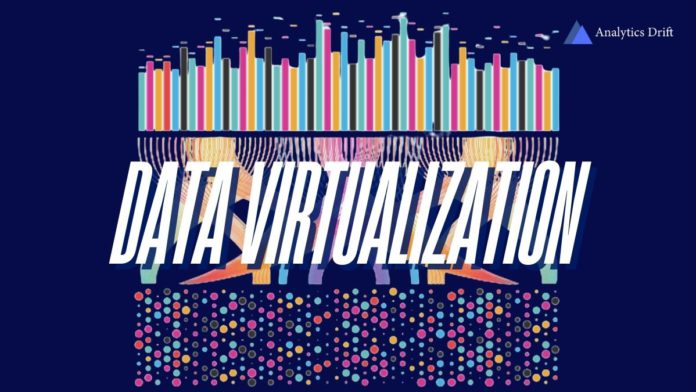For many businesses, including yours, the complexity of accessing and integrating data from various systems and formats can be a major challenge. Data virtualization offers a smart solution, simplifying data management and facilitating easy access to data from diverse sources without the need to move or copy it. According to Allied market research, the data virtualization market was worth $3.2 billion in 2021 and is expected to grow to $22.2 billion by 2031.
Data virtualization technology plays a crucial role in streamlining business operations and facilitating efficient real-time decision-making. If you’re looking to understand how this technology can be applied to your business, you’re in the right place!
What Is Data Virtualization?
Data virtualization is an advanced data integration technology that acts as middleware between different data sources and end-users. It allows you to retrieve and manipulate data from multiple sources without physically moving it into a single repository, such as a data warehouse.
By creating a virtual layer, the virtualization technology enables you to seamlessly integrate structured and unstructured data stored in different systems, databases, formats, and locations. You can then access the integrated data for various use cases, including enterprise systems, reporting, Business Intelligence (BI), or mobile and web applications.
Key Capabilities of Data Virtualization
- Unified Data View: Data virtualization allows you to combine data from multiple sources into a single virtual view of data. This helps you access and work with data without physically dealing with different systems.
- Real-Time Access: You can retrieve and process data on demand, providing up-to-date information whenever required. As a result, you can make decisions based on the latest data.
- No Data Replication: Leveraging data virtualization technology can help you reduce storage costs by reducing the need to copy or move data.
- Data Abstraction: You can hide the complexity of underlying data sources by providing a simple unified interface through data virtualization. It makes accessing and using data easier, even from different systems.
- Efficient Data Management: Data virtualization provides a secure, centralized layer to help you search, discover, and govern the available data. You can also explore hidden relationships between these datasets.
- Agile Development: Virtualized data systems allow you to quickly create and modify data views according to changing business needs. This agility speeds up project development and improves the time to solution.
- Analyze Business Performance: You can analyze your organization’s performance by comparing current and historical data from previous years. This will help you understand and plan for future improvements.
Importance of Data Virtualization in Cloud Computing
Data virtualization is crucial in cloud computing as it helps you simplify the integration of data stored across various cloud platforms. The virtual abstraction layer provides a unified view of data, eliminating the need for physically moving or replicating data. It also reduces storage costs and the complexity of managing multiple data sources in the cloud.
With data virtualization technology, you can enhance the scalability and flexibility of cloud environments. As your cloud infrastructure expands, data virtualization enables you to handle increasing data volumes without requiring significant changes to the system. It also strengthens data security by centralizing access control, ensuring that sensitive data is secured and compliance policies are upheld.
Top 3 Data Virtualization Tools
There are several data virtualization tools to help you manage your data efficiently. Let’s discuss the top three tools among them:
Denodo
Denodo is a leading logical data management platform that supports data virtualization. It allows your application to utilize data from several heterogeneous data sources. You can access and integrate data in real-time between different distributed systems without copying or moving data from its source.
The Denodo platform includes the following components:
- Virtual DataPort: This module allows you to create virtual views that help you combine data from different systems. It provides a JDBC/ODBC driver and SOAP/REST web services to allow you to query these views.
- Aracne: It enables you to crawl and index unstructured data from websites, email servers, file systems, and so on.
- ITPilot: You can access, structure, and query data on the Web using ITPilot.
- Scheduler: Scheduler allows you to schedule jobs to connect with the other modules of the Denodo platform.
TIBCO Data Virtualization
TIBCO Data Virtualization is a data virtualization system provided by TIBCO software. It allows you to aggregate disparate data sources on demand. Using the software, you can create logical, unified data views tailored to your analytical requirements. With support for JDBC, ODBC, REST, and SOAP, TIBCO Data Virtualization helps you connect to virtually any data source.
The TIBCO Data Virtualization (TDV) has the following modules to support all phases of data virtualization development, run-time, and management:
- Studio: An agile modeling, development, and resource management tool that helps you model, develop, and view data services. It also allows you to build custom transformations, optimize queries, and handle resources.
- Web UI: A browser-based interface includes a data catalog and data workbench for self-service data discovery. It facilitates efficient data integration and collaboration by enabling you to visualize, access, and manage virtualized data in real-time.
- Adapters: A module that offers various data source connectivity for databases, big data, cloud services, applications, etc. You can also build custom adapters using the Data Source Tool Kit.
- Cost-based and Rule-based optimizers: These optimizers are used to improve query performance.
- Manager: An administrative console that enables you to configure the user IDs, passwords, security profiles, and more.
- Deployment Manager: This module allows you to move all the projects across various instances in one go quickly.
- Monitor: You can access a detailed, real-time view of your TDV cluster, which will help you take corrective actions based on the performance indicators.
- Active Cluster: It works in association with load balancers to offer high scalability and availability.
- Business Directory: A self-service directory offers a list of published resources involved in one or more instances of TDV.
CData Virtuality
CData Virtuality is an enterprise data virtualization platform offered by CData Software. It is designed to meet increasing business demands by offering agile, scalable, and efficient data integration methods. This solution is suited for modern data challenges, including AI initiatives, flexible data architectures, and self-service analytics. Focusing on cloud-native readiness and minimizing physical data movement helps you ensure optimal performance and adaptability.
There are four key pillars for modern data management using CData Virtuality:
- Seamless Integration: Bridging the gap between modern digital and traditional systems, CData Virtuality facilitates real-time insights by enabling you to connect heterogeneous data sources. This ensures unified access to data, regardless of its location or format.
- Effortless Data Preparation: By integrating virtual and physical data models, the platform allows you to accelerate data preparation processes without scalability limitations.
- Robust Governance: CData Virtuality provides centralized governance by managing both physical and virtual data assets with related business, operational, and technical metadata.
- Accelerate Data Delivery: CData Virtuality makes it easy for you to deliver data across different environments, ensuring it reaches the suitable users at the right time.
Data Virtualization Benefits
- Time-to-Market Acceleration: Many data virtualization tools offer pre-built connectors, templates, and wizards that streamline deployment. This reduces the time and expertise required to integrate sources.
- Support for Modern Architectures: Modern data virtualization platforms align with data mesh and data fabric architectures. It supports distributed environments while maintaining a centralized, governed data layer.
- Improved Customer Satisfaction: By delivering faster insights and a comprehensive view of customer data, data virtualization helps you improve customer experience. Personalized services, faster response times, and better support result in higher satisfaction, which increases customer loyalty and drives revenue growth.
- Robust Security Mechanisms: Within data virtualization platforms, you can incorporate advanced security measures such as encryption, role-based access control, and audit trails. These mechanisms enable you to protect your sensitive personal and professional information even if it is accessed across multiple systems.
- Creation of Personalized Views: Data virtualization solutions include intuitive interfaces that allow you to create customized views of the data. These personalized views simplify complex datasets, allowing you to focus on insights rather than data preparation.
- Cost Efficiency: Traditional data integration methods require duplicating data across various systems, which increases storage and infrastructure costs. Using data virtualization, you can reduce this by creating virtual views of the data, enabling data access without physical replication.
Limitations of Data Virtualization
- Single Point of Failure: Data virtualization relies on a central server to provide connectivity to various sources, creating a single point of failure. If the virtualization server experiences downtime, it can disrupt access to all connected data sources, significantly affecting operations.
- Scalability Constraints: As the number of data sources and the volume of data increases, maintaining real-time access through virtualization becomes increasingly demanding. Scaling the infrastructure to handle these workloads efficiently can be costly and technically challenging.
- Limited Offline Support: Data virtualization systems usually do not store data permanently. This limitation makes them unsuitable for offline analysis, as all queries depend on live connections to the sources.
Use Cases of Data Virtualization
Some key areas where you can utilize data virtualization:
Real-time Analytics
Data virtualization provides a consolidated view of data from various sources, enabling real-time insights. Your business can access and process up-to-date data to improve decision-making speed and efficiency.
Hedge funds are investment firms that utilize data virtualization to integrate and analyze live market data, stock prices, and social media streams. It allows them to make informed and prompt investment choices.
Coforge, an IT services company that offers end-to-end software solutions, utilizes a data virtualization framework. This framework supports data analytics by enabling smooth access and control over data spread across several databases and systems.
360-Degree Customer View
A 360-degree view of customer information enables you to identify key attributes such as customer profiles, behavior, and demographics. Data virtualization has a significant role in creating this holistic view by integrating disparate data sources.
Retailers depend on data virtualization to aggregate information from systems such as point-of-sale, e-commerce, and loyalty programs and generate a 360-degree customer view.
Healthcare Industry
Healthcare operates under strict regulations, such as HIPAA, which mandates patient data security and proper management. Data virtualization enables healthcare providers to combine data from electronic medical records, insurance claims, and other sources into a single view.
Conclusion
Data virtualization transforms how your business accesses and utilizes data, enabling streamlined operations, cost efficiency, and real-time analytics. While challenges exist in scalability and dependency on live connections, the benefits often outweigh these limitations. By choosing the right virtualization tools and strategies, your business can leverage the full capabilities of data virtualization, improving productivity.
FAQS
What makes data virtualization different from ETL?
ETL (Extract, Transform, Load) enables you to move data into a central repository. In contrast, data virtualization creates a virtual layer that allows you to access data without physical data movement. This ensures faster insights and reduced storage requirements.
Can data virtualization be used with big data technologies?
Yes, data virtualization can integrate with big data technologies like Hadoop, Spark, and NoSQL databases.


